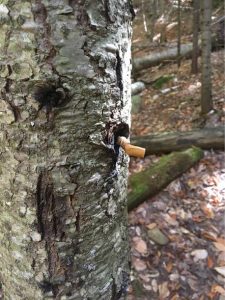Standing atop Hurricane Mountain, I look out to the northwest and spot Whiteface. It’s immediately recognizable with its ski sloped streaks, and if I look hard enough, I can see the castle built so FDR could reach the summit – a tiny speck from this distance. I wonder how many people are standing at that summit, staring back at me. The top of Hurricane is quiet. It occurs to me that two vastly different wilderness experiences – both valuable – can exist within eyeshot. With the issue of trail overuse, I wonder what the best management strategy is: should we attempt to disperse more people to peaks like Hurricane, or should we attempt to condense them into already high traffic areas with infrastructure, like Whiteface (so called ‘sacrificial zones’)?
When discussing my question with DEC official David Winchell and Forrester Tate Connor, both were of the mindset that dispersal is the best option. In fact, on Columbus Day weekend, officials spoke with hikers at rest areas and suggested possible alternative hikes to help spread out the traffic. Heavy amounts of foot traffic wears on trails, but Connor points to user experience as the most compelling reason for dispersal. He suggests that if you could take first time hikers and put them on less traveled paths like Vanderwhacker, they will learn proper hiking techniques in a more durable area, and have a completely different perception of how to interact with nature. “If your baseline is a 20-foot trail with 50 to 60 people around you at the summit, that changes everything after that,” Connor says. Winchell also makes an economic argument for dispersal, stating that “dispersal to other communities can help community economics.”
Rocci Aguirre and Emily Liebelt of the Adirondack Council further the dispersal argument. “The concept of a sacrificial area focuses on consuming rather than being sustainable,” says Liebelt. If we designate sacrificial areas of the park, we will use those areas until they are a “shell of what they once were,” and then promptly move on to destruct the next area. “The sacrificial argument speaks to a lack of imagination and a lack of resources,” says Aguirre.
But resources are lacking. A discussion with Tony Goodwin of Adirondack Trail Improvement Society (ATIS) revealed just how time, labor, and monetarily intensive it is to complete trail work. Goodwin is of the “sacrificial area” camp of thought. He jokingly estimated that, “$250 will pay for two steps.” If you can concentrate users into one area, you can focus your trail work. He points to the trail up Cascade as an example of success. Extensive work was done on the trail in the mid-80s, and “although it looks more worn than 30 years ago, it has stood up well,” despite seeing 600 hikers a day. Along with focused trail infrastructure, rangers, stewards, and foresters can also focus where they enforce and educate.
Ultimately, there is a limit to how much control one can have on where hikers go. As Winchell said, “the High Peaks has a mystique and provides a certain experience.” Goodwin agrees, “the fire tower peaks are nice, but no way can you claim they’re equivalent to the High Peaks.” People are naturally drawn to certain areas and experiences. In this way, we can only exercise so much autonomy over the sacrificial area versus dispersal outcome. So what’s the best course of action? Take individual responsibility when hiking. Educate. Educate. Educate. And as Aguirre says, “there has to be a public sense of ownership that these places deserve to be managed.”

